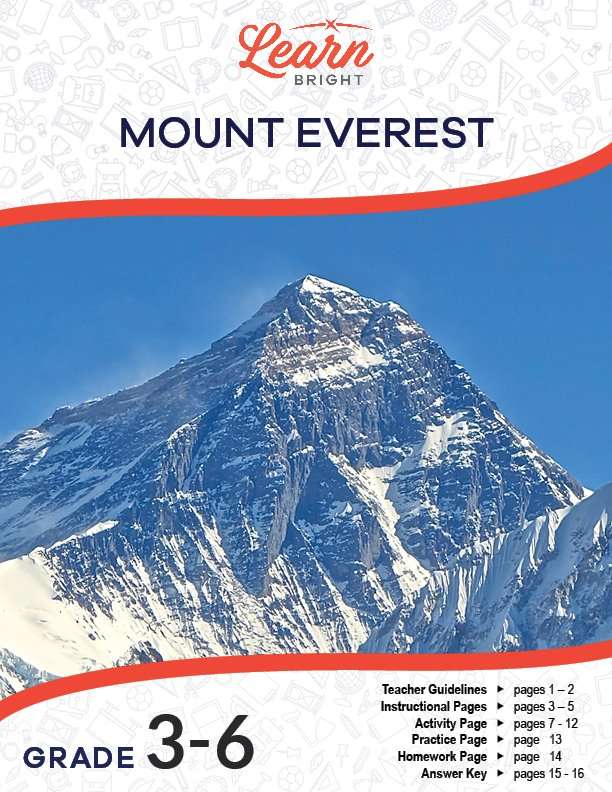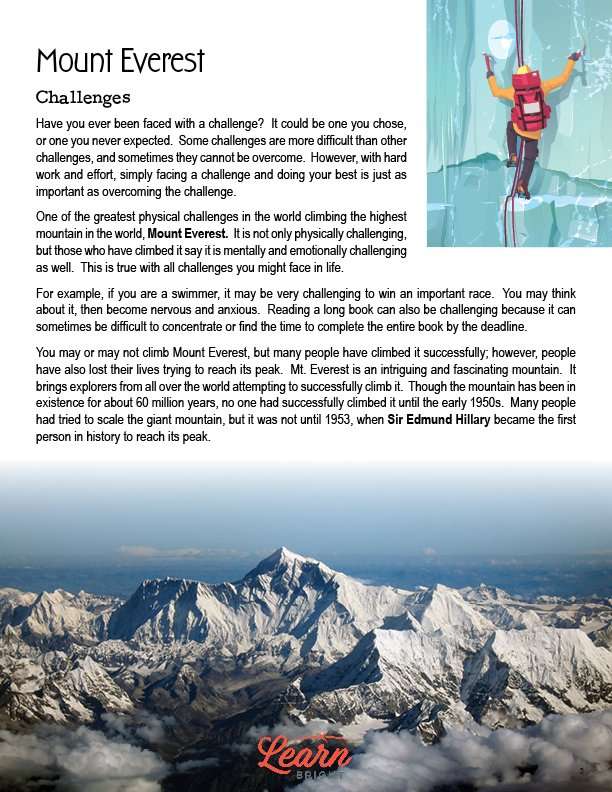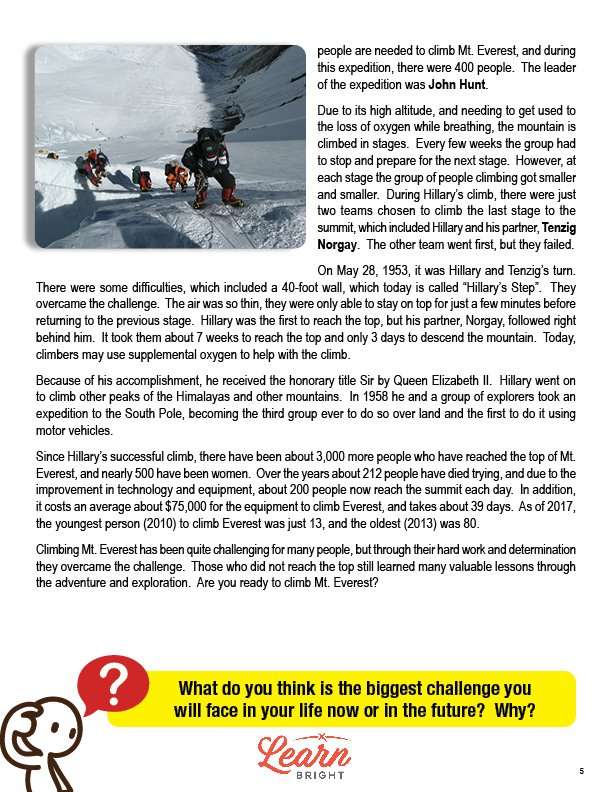Description
What our Mount Everest lesson plan includes
Lesson Objectives and Overview: Mount Everest introduces the students to Mount Everest, the highest mountain in the world. The lesson includes interesting facts, details, and information about climbing Everest and the people who have climbed the mountain. The lesson may also be used to show students that challenges can be overcome through hard work and effort. At the end of the lesson, students will be able to identify Mt. Everest and Edmund Hillary, list some facts about Mt. Everest, as well as explain the challenges related to climbing Mt. Everest. This lesson is for students in 3rd grade, 4th grade, 5th grade, and 6th grade.
Classroom Procedure
Every lesson plan provides you with a classroom procedure page that outlines a step-by-step guide to follow. You do not have to follow the guide exactly. The guide helps you organize the lesson and details when to hand out worksheets. It also lists information in the orange box that you might find useful. You will find the lesson objectives, state standards, and number of class sessions the lesson should take to complete in this area. In addition, it describes the supplies you will need as well as what and how you need to prepare beforehand. The supplies you will need for this lesson include scissors, game pieces, a container, and the handouts.
Options for Lesson
Included with this lesson is an “Options for Lesson” section that lists a number of suggestions for activities to add to the lesson or substitutions for the ones already in the lesson. Several of these suggestions are for the lesson activity—you can add additional questions or create a larger game board using poster board. You could also create an outdoor game board with a scale of 2 feet = 1000 feet and have students “ascend” the mountain; climbers must also descend the mountain to win the game. For an additional activity, you could invite a person who climbs mountains to speak to your students about that experience. Finally, you can allow your students to access the Internet to discover more information about Everest from the journals or blogs of Everest climbers.
Teacher Notes
The teacher notes page includes a paragraph with additional guidelines and things to think about as you begin to plan your lesson. This page also includes lines that you can use to add your own notes as you’re preparing for this lesson.
MOUNT EVEREST LESSON PLAN CONTENT PAGES
Challenges
The Mount Everest lesson plan includes three content pages. At the beginning of this lesson, students will think about whether they’ve ever faced a challenge. One of the greatest physical challenges in the world is climbing Mount Everest, the highest mountain in the world. This is not only physically challenging, but mentally and emotionally challenging as well. Many challenges are like this in some way.
For example, if you swim, it might be hard to win a race. If you start thinking about the race, you might become nervous or anxious. You might also find it challenging to read a long book, because you might have trouble concentrating or finding the time to read the whole book.
Most people will not climb Mount Everest in their lives, but many people have done so successfully. Others, however, have lost their lives trying to climb it. It’s a fascinating mountain that attracts explorers from all over the world. The mountain has existed for 60 million years, but no one had successfully climbed it until the early 1950s. Many people had tried, but Sir Edmund Hillary was the first to reach the peak in 1953.
The Highest Mountain
Mount Everest is 29,029 feet tall at its highest peak and grows about 1/4 inch every year. For comparison, the Empire State Building in New York is about 1,300 feet tall. It would take about 22 of them stacked on top of each other to reach Mount Everest’s height.
You can find Mount Everest in the Himalayas mountain range on the border of Nepal and Tibet in eastern Asia. The summit also borders China. Locals call the mountain Chomolungma, meaning “Mother Goddess of the Sky.”
Because of its size, the mountain attracts many visitors. It’s surrounded by glaciers and alpine lakes, which act as a source of water for the people of Nepal, India, Myanmar, Laos, Thailand, and even Cambodia, which is about 1,500 miles away.
Everest is also very cold. The weather can be deadly. The temperature is usually below zero degrees Fahrenheit, and never goes above freezing. During the winter, temperatures are usually about -33° F. During the summer, it’s usually around -2° F. Wind speeds can reach 200 MPH with a wind chill of -80° F. The mountain is covered in snow year round.
Climbers also have to deal with the high altitude of the mountain, which means they have less oxygen as they climb. Each breath you take climbing Mount Everest has 66% less oxygen than the breaths you take at sea level. This makes the climb very, very difficult.
The rugged terrain, snowfall, avalanches, and other dangers also all potentially await someone attempting the climb. This makes it almost, but not completely, impossible.
Climbing Everest
Sir Edmund Hillary was the first to climb Mount Everest in 1953. He was born in Auckland, New Zealand on July 20, 1919 and became an explorer and mountain climber at 16. He climbed his first large mountain when he was 20. Hillary was six feet five inches tall.
Hillary decided to climb Mount Everest at 33 years old. During this time, the government of Nepal only allowed one climbing expedition per year. They need many people on an expedition like this, and 400 people went on this expedition. A man named John Hunt led the expedition.
People climb the mountain in stages because of how difficult the journey is. They need to acclimate to less oxygen. At each stage, less and less people continued on. Only two teams climbed the final stage during Hillary’s expedition. Hillary and his partner, Tenzig Norgay, were in the second group. The first group failed.
Hillary and Tenzig left on May 28, 1953. They faced difficulties, like a 40-foot wall that we now call Hillary’s Step. They overcame the challenge but the air on top of the mountain was so thin that they could only stay for a few minutes. Hillary reached the summit first, with Norgay following. All in all, it took them seven weeks to reach the top, and three days to descend afterwards. Many climbers today use supplemental oxygen when they climb.
Queen Elizabeth II granted Hillary the honorary title of Sir for his accomplishment. He went on to climb other peaks in the Himalayas as well as other mountains. He also took a group of explorers on an expedition to the South Pole. This was the third group ever to make the trip via land and the first to do it with motor vehicles.
Since Hillary’s first climb, about 3,000 other people have reached the top of Mount Everest, about 500 of whom were women. About 212 people have died attempting the climb. Technology and equipment have improved, and now about 200 people a day reach the peak. It costs about $75,000 in equipment and an average of 39 days to climb today. As of 2017, the youngest person to climb Mount Everest was 13, and the oldest was 80.
Many people have faced and overcome the challenge of climbing Mount Everest. The people who reached the top learned many valuable lessons during their expeditions.
MOUNT EVEREST LESSON PLAN WORKSHEETS
The Mount Everest lesson plan includes three worksheets: an activity worksheet, a practice worksheet, and a homework assignment. You can refer to the guide on the classroom procedure page to determine when to hand out each worksheet.
CLIMBING MOUNT EVEREST ACTIVITY WORKSHEET
Students will work in groups of 2-4 to construct and play a board game about Mount Everest. Each group will cut out the question cards that they will use during the game and will mix them in a container. For the game, all players begin at the starting position on the game board. During their turn, each student will choose a question from the container. If they answer it correctly, they will move ahead one space. If they answer it incorrectly, they will stay where they are on the board. The game continues until a student reaches the peak.
MATCHING PRACTICE WORKSHEET
The practice worksheet asks students to match ten terms from the lesson with their descriptions. They will also tell the significance of 12 numbers as they relate to Mount Everest.
MOUNT EVEREST HOMEWORK ASSIGNMENT
For the homework assignment, students will first imagine they’ve just climbed Mount Everest and will write a letter to someone describing the climb. They will include some facts about Mount Everest, some problems they faced during their imaginary climb, and how they’re feeling mentally, physically, and emotionally. Next, they will answer five questions about the lesson material.
Worksheet Answer Keys
This lesson plan includes answer keys for the practice worksheet and the homework assignment. If you choose to administer the lesson pages to your students via PDF, you will need to save a new file that omits these pages. Otherwise, you can simply print out the applicable pages and keep these as reference for yourself when grading assignments.









